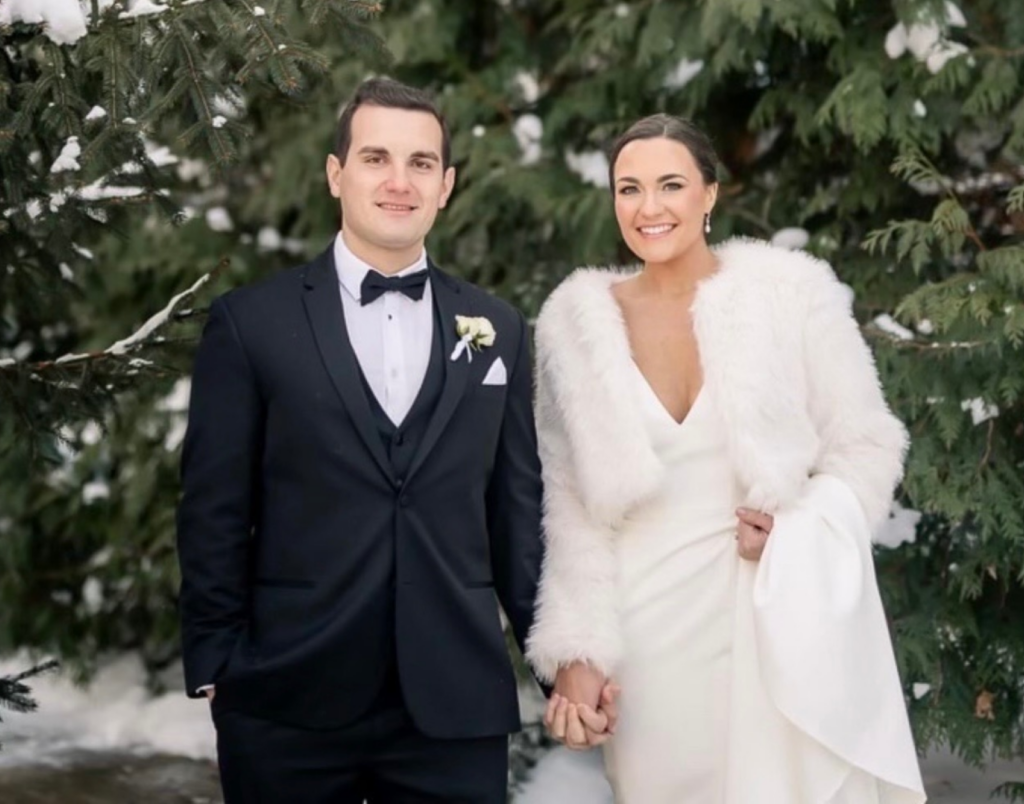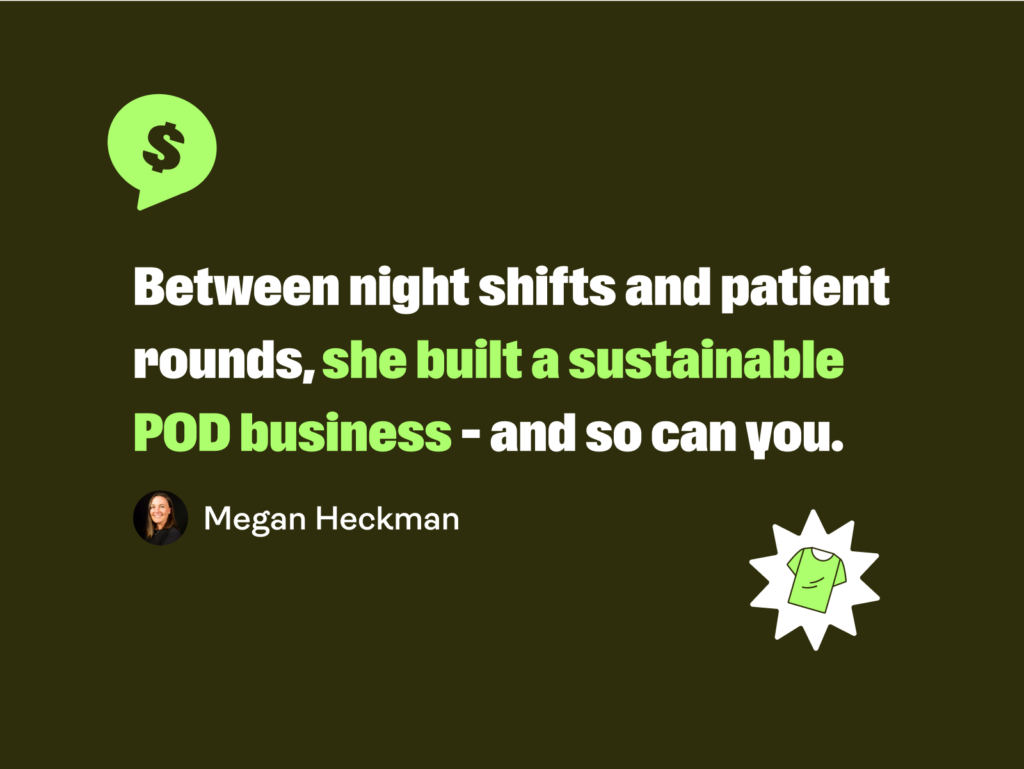Build your dream business today
If you’re looking for another ‘I made $10,000 in my first week’ story, this isn’t it, says Megan Heckman.
In a world of flashy print-on-demand (POD) success stories and overnight riches, Megan Heckman brings something different – proof that building a business takes time, grit, and a lot of learning.
Between night shifts and patient rounds, she built something remarkable: a sustainable POD business that confirms you don’t need to be a marketing or design expert to succeed.
This is her story – no fluff, no shortcuts, just real strategies that work.

Hi, Megan. What sparked your journey into entrepreneurship?
“If I had to look back five years, I would never have imagined this is where my life would be. I graduated with a sports medicine degree and was exploring everything in health sciences, like physical and occupational therapy, before deciding on nursing school.
After completing an accelerated program, I landed a job as a pediatric trauma nurse at a children’s hospital. That’s when I met Chris, my husband, who was successfully running POD stores. He noticed my creative side and mentioned that it would be perfect for me.
He explained that I could supplement my income without quitting my job, saying, ‘If all the guys I’m living with can do this, you 100% can do the same.'”
How did you balance both careers during the transition?
“The early days were intense. I worked full-time in nursing while building my POD business in every spare moment. I would work night shifts at the hospital, come home and answer customer service emails, sleep, wake up, handle more business tasks, and then head back to the hospital.
While it was exhausting, each store taught me valuable lessons that I applied to the next one. Those early days of balancing both careers helped me develop strong time management skills and gave me a safety net while building my business. It wasn’t about making an immediate jump – it was about smart, gradual progression.”

What is the biggest misconception about starting a POD business?
“The biggest misconception comes from social media. Nobody wants to watch a video about taking nine months to make your first sale – they want to see ‘I made $10,000 in four days.’
While social media has helped open people’s eyes to POD becoming a real business, it’s created unrealistic expectations. People think it will work in 30 days or less, and if it doesn’t, they quit or think those successful sellers must be special.
Like any business, POD takes time to master. Just as it took me months to feel comfortable as a nurse, you must give yourself time to learn and grow in this business.”
How important would you say niche selection is when starting?
“Chris and I always start with one broad niche like history, for example, and one specific product, usually t-shirts. Many newcomers feel pressured to offer everything – mugs, shower curtains, phone cases – but it’s much more effective to master one product first.
Go for a niche you’re genuinely interested in. With our history store, Chris’s dad, Pete, loves history so much that he’s always reading history books.
When you have that passion, you understand your customer better because you are the customer. You’re not just looking for designs you like, but creating content that speaks to a community you’re part of.”

How did your first store experience shape your perspective on research?
“My first store had no niche. I found designs I liked, thinking, ‘So many people are going to love my designs!’ I learned the hard way that not many people share my exact taste, and that’s okay. The first store wasn’t a financial success, but it was a priceless lesson.
Now I tell everybody to do research. Go out there and look into different niches and products, as well as various designs and styles. Study what’s already selling in the niche, what isn’t, and reverse engineer what we’re seeing and putting into our own stores.“
Why did you choose Printify as your POD partner?
“Initially, I chose Printify on Chris’s recommendation, but over time, I discovered why it was the right choice. Honestly, it comes down to pricing – I don’t think you can find better print-on-demand costs anywhere else, which directly impacts your profit margins.
When running a Shopify store with advertising costs, those margins become crucial. While platforms like Etsy can generate organic sales through SEO, Shopify requires consistent ad spending to drive traffic.
With Printify’s pricing, we can maintain 15-20% margins even with advertising costs, compared to the 5% you might see with other providers.
Next, selecting and testing different Print Providers has also been invaluable to our business. I always tell new sellers to order the same design from various providers and compare quality and shipping speed.
Having this flexibility to choose based on quality and turnaround time has helped us maintain customer satisfaction.”

How do you handle international fulfillment?
“We’ve developed a strategic approach to international orders. We created what we call our ‘Printify Dream Team’ for fulfillment – we have providers in the UK, Europe, Australia, and Canada. This helps us optimize shipping times and costs for international customers.
For example, if someone orders from Latvia, we can have their order fulfilled by our European Print Provider rather than shipping from the US. This reduces shipping costs and ensures faster delivery times.
How important was setting up an LLC as a POD seller?
“Honestly, I never thought about running it without one. In Pennsylvania, where I got my LLC, I think I paid $250 – it wasn’t a huge amount of money that would break the bank.
When you dive into the protections you have with an LLC, it separates your personal finances from your business.
The last thing I want is for a beginner to get taken advantage of and tied up to something that could put their personal assets on the line.
Even if it’s a side hustle and starts doing well, you wouldn’t want that tied to your house, your retirement funds, or anything else.”

Beyond legal structure, what’s your approach to managing business finances?
“Chris taught me a crucial lesson about financial management. We’d set aside a specific amount for the business and emotionally detach from it. Pick an amount you’re comfortable with and treat it as already spent.
This helps avoid the mindset of ‘I spent $200 on ads, so I need to make $250 back immediately,’ which can lead to rushed decisions. When setting up your initial budget, consider all aspects – product testing, marketing, legal setup, and a buffer for unexpected expenses.
This financial cushion allows you to make calculated decisions rather than emotional ones. Remember, it’s better to start small and scale up than to overextend yourself early on.”
What’s your strategy for testing new designs?
“We recommend having at least 100 designs in your shop to give Facebook enough data to find winners that are getting clicks. When you’re ready to start advertising, take $100 and start your campaign on a Thursday.
Run it Thursday, Friday, Saturday, and Sunday, then turn it off late Sunday. This gives you tons of data about your designs and stores for just $100 spent over four days.
After that, analyze which designs got cheap clicks and showed real interest.
Look at what aspects of these designs people were interested in – was it the saying? Was it all typography with something funny about the niche? Or was it an artistic design we can replicate in a different area of the same niche?
We always aim to sell two or more shirts to a customer because then we’ll make a better margin. So, we’ve developed various strategies and tools on our site to encourage multiple purchases.”

How do you handle customer service challenges?
“Something we’ve done with our customer service that has had positive feedback is our approach to returns. Obviously, with POD, we can’t accept traditional returns – where would we return it to?
Instead, we’ll say, ‘Hey, we get the fit isn’t right. We’d love to give you a gift card for store credit or send you a new shirt.’ Then, we encourage them to give the original shirt to a friend or donate it, tying it back to our brand’s mission. This approach has resulted in incredible customer loyalty and word-of-mouth marketing.
We also maintain transparency about being a small business, especially regarding shipping times. When customers understand they’re supporting a small business rather than a large corporation, they’re often more patient and understanding.”
What’s your experience with different selling platforms?
“I’ve always started on Shopify because that’s what Chris had done. As our brands have grown, we’ll put our top sellers on Etsy, because some people may not be comfortable purchasing from our Shopify site if they’ve never heard of it.
Typically, people search for our brand on Google, Amazon, and Etsy and feel more comfortable purchasing from those platforms.
So, we use Etsy to capture some of that natural organic search traffic. But other than that, I’ve never really focused on Etsy as much of a priority as our Shopify store.”
What’s your approach to research and trend analysis?
“Today, much more research is involved in everything we do. Taking History Tees as an example, we found one design – a Lincoln five-star design – that really took off.
We noticed people in the history niche particularly enjoyed sarcastic humor related to historical events. Chris’s dad, Pete, would read history books, and we’d collaborate to find different historical events and create similar humorous concepts around them.
When looking for trends, don’t get too caught up in what other people are doing on specific platforms. Instead, try to get inspired by broader trends or themes from art, movies, or literature. SEO and competitor analysis are important, but don’t make them your sole focus.”

What role has community played in your success?
“One of the main challenges when running an online business is working alone. Although it might sound like a dream to some people, it has its disadvantages. You can’t get advice from anyone and don’t have a way to share your concerns or problems.
We share what we’ve learned because we remember how valuable it was to have someone guide us through the early stages. In our community, there are no stupid questions – whether it’s about LLC formation, design techniques, or marketing strategies.
This support system has been priceless for our growth and the success of our community members.”
Looking back at your journey from nursing to POD, how has this career change impacted your life?
“This transition has given me flexibility and opportunities I never imagined possible. While I loved nursing and helping people, POD has allowed me to impact lives differently while being free to live on my own terms.
We can travel, work from anywhere, and build something meaningful. I would never have had these experiences without taking that first step into entrepreneurship.
The skills I learned as a nurse – attention to detail, problem-solving, and customer care – have proved invaluable in running my POD business.”
For more about Megan and her amazing work, check her out at www.mysticpod.com and www.skool.com/heckman.












